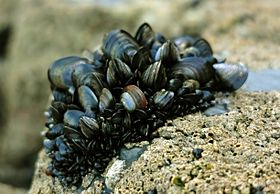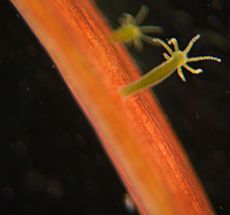Sessility (zoology) facts for kids

Sessile is a common word in biology. It describes living things that stay in one spot. They don't move around much. Think of them as being "stuck" to something. This is the opposite of being motile, which means you can move freely. Many sessile creatures live in the ocean or freshwater.
Contents
What Does "Sessile" Mean?
When a plant or animal is sessile, it means it is fixed in one place. It usually attaches itself to a surface. This surface could be a rock, the seafloor, or even another living thing. They often stay in that spot for most of their adult lives. They choose a good spot and then stay there as long as they can. Many sessile forms can move a little if they really need to. But mostly, they prefer to stay put.
How Do Sessile Organisms Stay Put?
Sessile organisms often make a special sticky substance. This substance helps them hold onto their chosen surface. For example, barnacles use a very strong glue. Mussels use strong threads called byssal threads. These threads help them cling tightly to rocks or other mussels. This keeps them safe from strong currents or waves.
Life Cycle of Sessile Animals
Many sessile animals have an interesting life cycle. Their young forms, called larvae, are often motile. This means the larvae can float or swim freely in the water. This is important because it helps them find new places to live. It also helps them spread out. Once a larva finds a good spot, it settles down. Then it changes into its adult form. The adult form then becomes sessile, staying in that one place.
Examples of Sessile Organisms
There are many cool examples of sessile organisms.
- Sponges are simple animals that are always sessile as adults. They filter food from the water.
- Corals are tiny animals that build large, hard skeletons. These skeletons form coral reefs. Each coral animal is sessile.
- Barnacles are crustaceans that attach themselves to rocks, ships, or even whales. They have hard shells and filter food from the water.
- Mussels and oysters are types of shellfish. They attach to surfaces and filter food.
- Sea anemones usually attach to rocks. They can sometimes slowly slide along a surface.
- Hydras are small freshwater animals. They usually attach to plants or rocks. They can detach and move if needed.
These organisms have adapted to their stationary lifestyle. They have special ways to get food and protect themselves.
See also
 In Spanish: Sesilidad (biología) para niños
In Spanish: Sesilidad (biología) para niños


